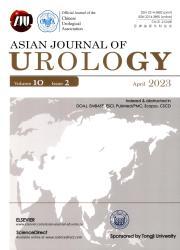Risk factors for symptomatic lymphoceles in patients undergoing robot-assisted radical prostatectomy with pelvic lymph node dissection: What we learned after more than 350 cases
IF 2.4
3区 医学
Q2 UROLOGY & NEPHROLOGY
引用次数: 0
Abstract
Objective
We investigated patients who underwent robot-assisted radical prostatectomy (RARP) with pelvic lymph node dissection (PLND), analyzing the prevalence and risk factors associated with symptomatic lymphoceles (SLCs).
Methods
We evaluated 354 consecutive patients who underwent RARP with PLND by our team between June 2016 and December 2022. After analyzing the prevalence of SLCs, patients were divided into two groups, with and without SLCs. The variables were age, body mass index (BMI), prostate-specific antigen, surgery time, blood loss, length of stay, International Society of Urological Pathology score in the pathology, and the number of lymph nodes removed. These variables were compared between these groups using the Chi-square test and Student's t-test, according to the type of the variable. In all analyses, a significance level of <0.05 was considered.
Results
The prevalence of SLCs in this sample of patients undergoing RARP with PLND was 2.0% (7/354), which is slightly lower than the minimum rate reported in the literature. In our analysis, BMI (p=0.041), the number of lymph nodes removed (p=0.007), and length of hospital stay (p=0.007) were factors associated with the presence of SLCs.
Conclusion
The prevalence of SLCs in patients undergoing RARP with PLND is approximately 2.0%. Higher BMI, greater number of lymph nodes removed, and longer length of hospital stay are factors associated with the presence of SLCs.
接受机器人辅助根治性前列腺切除术伴盆腔淋巴结清扫的患者出现症状性淋巴囊肿的危险因素:我们在超过350例病例后了解到的情况
目的研究机器人辅助根治性前列腺切除术(RARP)合并盆腔淋巴结清扫术(PLND)的患者,分析症状性淋巴细胞(SLCs)的患病率及相关危险因素。方法我们评估了2016年6月至2022年12月期间由我们团队连续接受RARP合并PLND的354例患者。在分析SLCs的患病率后,将患者分为有SLCs和无SLCs两组。变量为年龄、体重指数(BMI)、前列腺特异性抗原、手术时间、出血量、住院时间、国际泌尿病理学会病理评分、淋巴结切除数。根据变量的类型,使用卡方检验和学生t检验比较这些变量在这些组之间的差异。所有分析均考虑显著性水平为<;0.05。结果在接受RARP合并PLND的患者中,SLCs的患病率为2.0%(7/354),略低于文献报道的最低率。在我们的分析中,BMI (p=0.041)、淋巴结切除数(p=0.007)和住院时间(p=0.007)是与SLCs存在相关的因素。结论行RARP合并PLND患者SLCs患病率约为2.0%。较高的身体质量指数、较多的淋巴结切除和较长的住院时间是与SLCs存在相关的因素。
本文章由计算机程序翻译,如有差异,请以英文原文为准。
求助全文
约1分钟内获得全文
求助全文
来源期刊

Asian Journal of Urology
UROLOGY & NEPHROLOGY-
CiteScore
4.00
自引率
3.80%
发文量
100
审稿时长
4 weeks
期刊介绍:
Asian Journal of Urology (AJUR), launched in October 2014, is an international peer-reviewed Open Access journal jointly founded by Shanghai Association for Science and Technology (SAST) and Second Military Medical University (SMMU). AJUR aims to build a communication platform for international researchers to effectively share scholarly achievements. It focuses on all specialties of urology both scientifically and clinically, with article types widely covering editorials, opinions, perspectives, reviews and mini-reviews, original articles, cases reports, rapid communications, and letters, etc. Fields of particular interest to the journal including, but not limited to: • Surgical oncology • Endourology • Calculi • Female urology • Erectile dysfunction • Infertility • Pediatric urology • Renal transplantation • Reconstructive surgery • Radiology • Pathology • Neurourology.
 求助内容:
求助内容: 应助结果提醒方式:
应助结果提醒方式:


